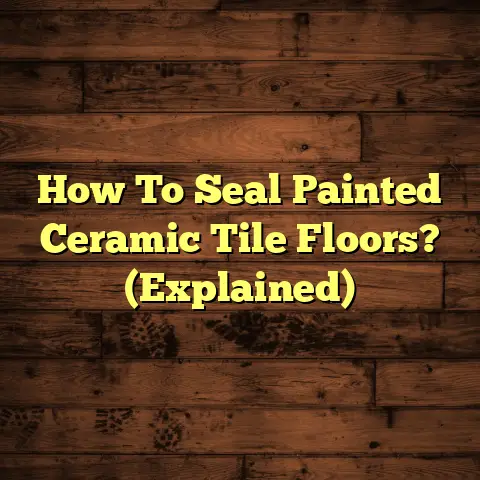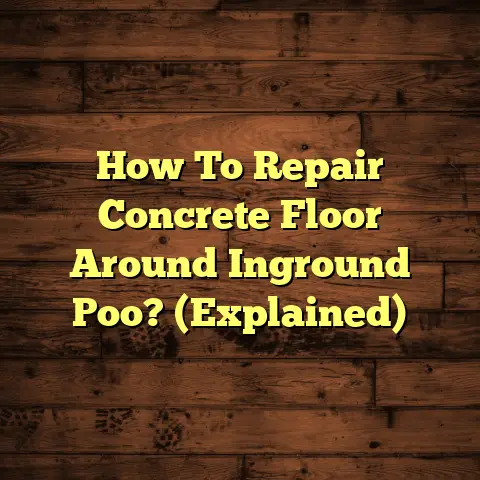Padding Under Vinyl: Needed? (6 Things To Check!)
It’s a great question!
Choosing the right flooring is a big deal.
It impacts how long your floor lasts and how well it performs.
Vinyl’s popular because it’s affordable, looks good, and can take a beating.
Today, we’re diving deep into the world of padding under vinyl.
We’ll explore the pros, the cons, and the crucial things you need to consider before making a decision.
Let’s get started!
Section 1: The Basics of Vinyl Flooring
Okay, let’s break down vinyl flooring.
It’s not your grandma’s linoleum anymore!
Modern vinyl is a multi-layered synthetic flooring product.
There are a few main types:
-
Luxury Vinyl Tile (LVT): Designed to mimic the look of ceramic or stone tile.
-
Luxury Vinyl Plank (LVP): Made to resemble hardwood planks.
-
Sheet Vinyl: Comes in large rolls and offers a seamless look.
What’s so great about vinyl?
Well, it’s water-resistant (a lifesaver in kitchens and bathrooms!), super easy to clean, and comes in a ton of styles.
You can find vinyl that looks like real wood, stone, or even abstract designs.
Now, where does padding fit in?
Traditionally, padding (or underlayment) is used under carpets and laminate flooring to add comfort, insulation, and sound absorption.
But is it necessary for vinyl?
Keep reading!
Section 2: What is Padding and Its Purpose?
Let’s define our terms.
Flooring padding is a layer of material installed between the subfloor and the finished flooring.
Think of it as a cushion for your feet and a buffer for your floor.
There are different types of padding, each with its own characteristics:
Foam Padding: Usually made from polyurethane or memory foam.
It’s affordable and provides good cushioning.-
Rubber Padding: Offers excellent sound absorption and durability. Often used in commercial settings.
Felt Padding: Made from recycled fibers.
It’s environmentally friendly and provides a firm, supportive base.
Padding does a few key things:
-
Comfort: Makes the floor feel softer and warmer underfoot.
-
Insulation: Helps to regulate temperature and reduce energy costs.
-
Sound Absorption: Dampens noise, especially foot traffic and impact sounds.
-
Durability: Protects the finished floor from wear and tear by absorbing impact.
Section 3: The Case for Padding Under Vinyl Flooring
Alright, let’s make the case for using padding under vinyl.
Why might you want to consider it?
First off, comfort.
Let’s be honest, vinyl can feel a little hard and cold, especially in the winter.
Padding adds a layer of cushioning that makes a noticeable difference.
Imagine walking barefoot on a vinyl floor with padding versus one without – it’s a different experience!
Next up: sound dampening.
If you live in an apartment or have kids who love to run around, padding can be a game-changer.
It absorbs footfall noise and prevents it from traveling to other rooms or floors.
Trust me, your downstairs neighbors will thank you!
I’ve worked on countless condo projects where soundproofing was a major concern.
Adding a quality rubber underlayment under LVP made a huge difference in reducing noise transmission.
Then there’s thermal insulation.
Padding can help to insulate your floor, keeping it warmer in the winter and cooler in the summer.
This can lead to lower energy bills and a more comfortable home overall.
In colder climates, this is especially important.
I once installed vinyl flooring with a thermal underlayment in a cabin in the mountains.
The owners were amazed at how much warmer the floor felt compared to their old tile.
Section 4: The Case Against Padding Under Vinyl Flooring
Now, let’s flip the script. Why wouldn’t you use padding under vinyl?
The biggest argument is that vinyl can be installed directly on a properly prepared subfloor.
Many vinyl products, especially LVT and LVP, are designed to be durable and resilient enough to withstand everyday wear and tear without padding.
A well-prepared subfloor is key here.
It needs to be level, clean, and free of any imperfections.
If the subfloor is in good shape, padding might not be necessary.
But here’s a word of caution: certain types of padding can actually cause problems.
If the padding is too thick or too soft, it can lead to buckling or indentations in the vinyl.
This is especially true with sheet vinyl, which is more susceptible to these issues.
I’ve seen firsthand what happens when the wrong padding is used.
In one case, a homeowner installed a thick foam padding under sheet vinyl, and within a few months, the floor started to buckle and ripple.
It was a costly mistake that could have been avoided with proper research.
Also, think about moisture.
In areas prone to moisture, like basements or bathrooms, padding can trap moisture and lead to mold or mildew growth.
This is a serious concern that needs to be addressed.
Section 5: Six Essential Factors to Check Before Deciding on Padding
Okay, so how do you decide whether or not to use padding under your vinyl flooring?
Here are six essential factors to consider:
1. Subfloor Condition
This is HUGE.
The subfloor is the foundation of your entire flooring system.
It needs to be in good shape before you even think about installing vinyl.
Levelness: Is the subfloor level?
Use a long level to check for any dips or humps.
An uneven subfloor can cause the vinyl to flex and crack over time.Moisture Content: Is the subfloor dry?
Use a moisture meter to check the moisture content.
Excessive moisture can lead to mold, mildew, and adhesive failure.Cleanliness: Is the subfloor clean and free of debris?
Sweep, vacuum, and scrape away any dirt, dust, or old adhesive.
If your subfloor is uneven or damaged, padding can help to smooth out imperfections and provide a more stable base for the vinyl.
However, keep in mind that padding is not a substitute for proper subfloor preparation.
2. Type of Vinyl Flooring
Not all vinyl is created equal.
The type of vinyl you choose will influence whether or not you need padding.
LVT and LVP: These are generally more rigid and durable than sheet vinyl.
They can often be installed directly on a well-prepared subfloor without padding.Sheet Vinyl: This is more flexible and susceptible to indentations.
Padding can help to protect it from damage and provide a more comfortable feel.
Always check the manufacturer’s recommendations.
They will specify whether or not padding is required or recommended for their particular product.
3. Intended Use of the Space
Think about how the space will be used.
Is it a high-traffic area like a hallway or kitchen?
Or is it a low-traffic area like a bedroom or closet?
-
High-Traffic Areas: Padding can help to protect the vinyl from wear and tear and provide a more comfortable surface to walk on.
-
Low-Traffic Areas: Padding may not be necessary, especially if the subfloor is in good condition.
Commercial spaces, like offices or retail stores, often benefit from padding because of the high volume of foot traffic.
In residential spaces, consider the specific needs of each room.
4. Acoustic Considerations
Do you need to reduce noise in the space?
Padding can significantly improve the acoustic properties of a room by absorbing sound and reducing sound transmission.
Sound Transmission: This is the sound that travels through the floor to other rooms or floors.
Padding can help to block sound transmission.Sound Absorption: This is the sound that is absorbed by the floor itself.
Padding can help to reduce echoes and reverberation.
If you live in an apartment or have a home theater, padding is a great way to improve the sound quality of the space.
5. Comfort and Insulation Needs
How important is comfort to you?
Do you want a floor that feels warm and soft underfoot?
Padding can make a big difference in the overall comfort of your vinyl floor.
Consider your climate.
In colder climates, padding can help to insulate the floor and keep it warmer.
In warmer climates, padding may not be as necessary.
Personal preferences also play a role.
Some people prefer a firmer floor, while others prefer a softer floor.
Padding can help you to achieve the desired level of comfort.
6. Installation Methodology
How will the vinyl be installed?
The installation method can affect the need for padding.
Glue-Down Installation: This is where the vinyl is glued directly to the subfloor.
Padding is generally not used with glue-down installations.Click-Lock Installation: This is where the vinyl planks or tiles snap together.
Padding can be used with click-lock installations, but it’s important to choose a padding that is compatible with the click-lock system.
Are you planning to DIY the installation or hire a professional?
Professional installers will have the experience and knowledge to help you choose the right padding for your specific needs.
Conclusion
So, is padding under vinyl needed?
As you can see, there’s no one-size-fits-all answer.
It depends on a variety of factors, including the subfloor condition, the type of vinyl, the intended use of the space, acoustic considerations, comfort and insulation needs, and the installation methodology.
While there are compelling reasons both for and against using padding, the final decision should be based on your individual circumstances, preferences, and specific flooring conditions.
Weigh the factors we’ve discussed carefully, and don’t hesitate to consult with a flooring professional for personalized advice.
Making an informed choice will ensure that you get the most out of your vinyl flooring for years to come.
Good luck with your flooring project!





